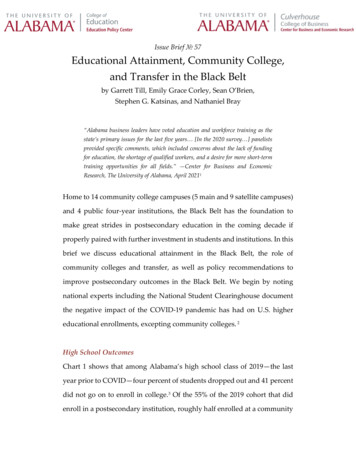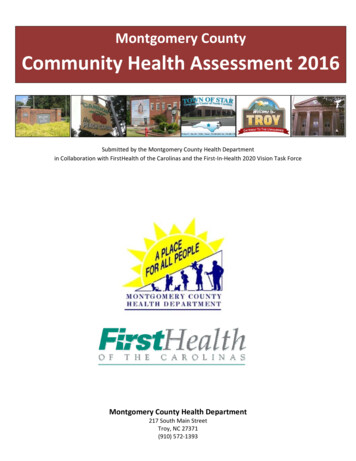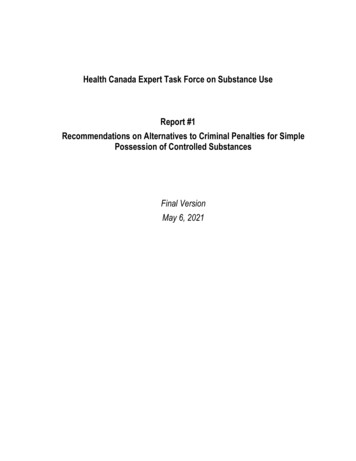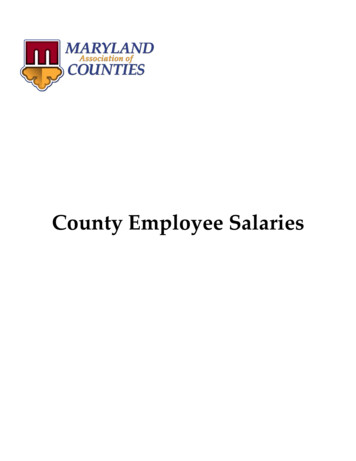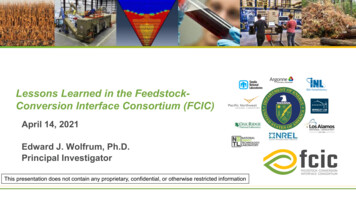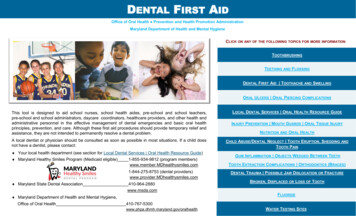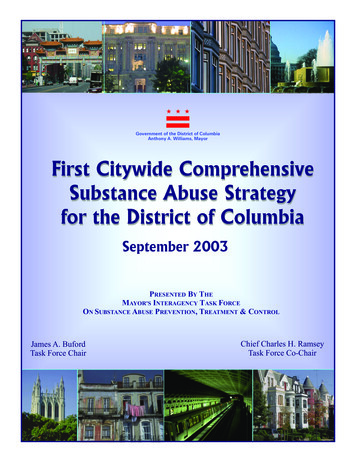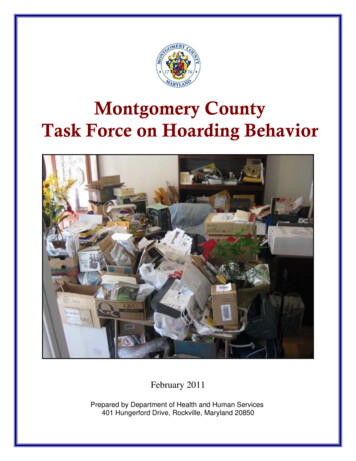
Transcription
Montgomery CountyTask Force on Hoarding BehaviorFebruary 2011Prepared by Department of Health and Human Services401 Hungerford Drive, Rockville, Maryland 20850
Montgomery County Task Force on Hoarding Behavior ReportTable of ContentsSectionPageExecutive Summary .i-xAccomplishments and Challenges .11.0 Introduction.22.0 Background/History.3-73.0 Montgomery County Task Force on Hoarding Behavior .8-94.0 Hoarding Program Description .10 - 135.0 Resources .14 - 166.0 Hoarding – Montgomery County’s Plan Ahead .17 - 237.0 References.248.0 Appendices.25Appendix A – Montgomery County Hoarding Task Force“Cooperative Agreement Among Participating Agencies” .26 - 37Appendix B – Hoarding Screening Rating Scale.38 - 39Appendix C – Internal Resource Contact List .40 - 41Appendix D – Hoarding Response Flow Chart; Decision Tree A –Primary Focus People; Decision Tree B – Primary Focus Structure.42 - 44Appendix E – “Collect? Clutter? Hoarding? Which one is it?”Hoarding Brochure.45 - 46Appendix F – Charter for Montgomery County Task Force onHoarding Behavior.47 - 49Appendix G – Montgomery County Task Force on Hoarding BehaviorMembership List .50Appendix H – Montgomery County Case Study Vignettes.51 - 57
EXECUTIVE SUMMARY:A National and Local ProblemWhat is Hoarding? Hoarding is the acquisition of, and failure to discard a large number ofpossessions in a residence which appear to be useless or of limited value. Living spaces, furniture,appliances and utilities are sufficiently cluttered as to prevent their intended use, which could pose asignificant risk to health, safety or the maintenance of housing.Signs and Symptoms of Hoarding Clutter blocking egress and ingress (windows and doors). Clutter making it difficult, impossible and/or unsafe to use the kitchen or bathroom for theirintended purposes. Presence of infestations (mice, rats, roaches) as a result of clutter. Damage to the housing structure – walls, ceilings, floors. Accumulated items unsafely stored too close to the stove, oven, heater, fans, portableheaters, or furnace.Hoarding behaviors can occur concurrently with a number of psychiatric disorders, such GeneralizedAnxiety Disorder Depression, Obsessive Compulsive Disorder, various personality disorders or as adistinct cluster of behaviors.National statistics indicate that 2-5% of the population suffer from hoarding in one form oranother. Based on these estimates, Montgomery County has approximately 20,000 – 50,000potential hoarders. With increased public awareness, even if only 10% of these residents areidentified as requiring services, it’s conceivable that between 2,000 – 5,000 residents needassistance when addressing a hoarding situation. Clearly, this places a burden on alreadyconstrained County resources, and will require close communication, coordination andcollaboration between local government and private partners.The cases discussed in this report exemplify the necessity for effective information sharing amongrelevant County and private agencies. Inter-agency collaboration will enable each department torespond appropriately to specific hoarders, address recidivism cases, share information andresources, and reduce the duplication of efforts. (See Appendix A “Task Force on HoardingBehavior Cooperative Agreement Among Participating Agencies”).iMontgomery County Task Force on Hoarding Behavior Report
The County government agencies primarily responsible for responding to hoarding situationsinclude: Department of Fire/Rescue Department of Housing and CommunityAffairs (DHCA) County Attorney’s OfficeDHHS Adult Protective Services (APS)DHHS Child Protective Services (CPS)DHHS Special Needs HousingDepartment of Police/Animal ServicesDHHS Crisis CenterIn addition to the above County departments, the Task Force on Hoarding Behavior (TFHB)includes members from the Housing Opportunities Commission (HOC) and Cities of Rockville,Gaithersburg, and Takoma Park. These departments and municipalities are expected to address theconsequences of excessive hoarding, which pose a risk, not solely to the individual but also to thequality of life, safety and well-being of an entire apartment building or neighborhood.Currently, there is minimal data available on the number of hoarding cases served, number ofreferrals to multiple agencies, hours spent by investigators, case managers and/or otherpractitioners, cost to provide the multitude of services needed to stabilize cases and/or the overallfinancial burden imposed on service providers and landlords.Figure 1 below provides a snapshot estimate of the hoarding incidents over the past three fiscalyears. (These figures include duplicate counts due to multi-agency involvement.) DHCA reportsan average of 85 cases a year and APS has seen an increase in referrals. Overall, the counts areexpected to rise exponentially as public media attention to the hoarding issue continues and ourpopulation ages.AGENCYFY 2008FY 2009FY 2010FY 2011 (Projected)596780 (actual)9612 - 1514 - 1815 - 2020 - 25NANANANAFire/Rescue35 - 4035 - 4035 - 4035 - 40Animal Services15 - 2015 - 2015 - 2015 - 20DHCA75 - 10075 - 10075 - 10075 – 100APSCrisis CenterCPSFigure 1 Montgomery County Estimated and Projected Number of Hoarding Cases(2008 – 2011)iiMontgomery County Task Force on Hoarding Behavior Report
Montgomery County Task Force on Hoarding Behavior FormedThe TFHB was formed in September 2009 as a collaborative endeavor to: Share information, expertise and resources to better address the complexity of hoardingsituations. Develop a concerted and coordinated multi-agency intervention strategy.The TFHB has met monthly in various group configurations to develop goals, tools and policyrecommendations.GOALS: The near term goals established by the TFHB are as follows:1. Provide a coordinated response to hoarding cases to promote the health and safety of allaffected residents, through the efforts of public and private agencies.2. Facilitate the ability of participating agencies to share information, expertise and resourcesin order to better understand and respond to this debilitating and/or potentially dangerousbehavior.3. Determine the extent of the hoarding problem in Montgomery County through multiagency collaboration and consistent data collection/reporting methods.4. Establish a 4-point Hoarding Awareness/Intervention Program consisting of:a. Awarenessb. Identificationc. Proactive Assistance/Interventiond. Follow-up/monitoring methods5. Develop practical tools and identify additional resource gaps.6. Develop policies and practices to reduce and prevent the incidence of severe hoardingamong our residents.iiiMontgomery County Task Force on Hoarding Behavior Report
Figure 2 below lists work tools and documents developed by the work groups over the past year.These tools and documents augment interagency efforts to identify and intervene in cases ofhoarding behavior as well as to help educate the public about the seriousness of hoarding andresources available to address this problem.Two of the newly developed tools, the Interagency Hoarding Response Matrix (Appendix A –Attachment B) and Hoarding Screening Rating Scale (Appendix B) are now being used withinCounty government.Product/ToolBenefits/Results Cooperative Agreement AmongParticipating Agencies(Appendix A) Facilitates Hoarding collaboration andTeamings and addresses concern amongmulti-agencies for sharing information. Interagency Hoarding Response Matrix(Appendix A – Attachment B) Facilitates County’s hoarding proactiveplan by providing points of contact forappropriate agencies to contact. Hoarding Screening Rating Scale(Appendix B) Now being used by Fire CodeEnforcement, DHCA Code Enforcementand Animal Services to ensure accuratecommunication. Internal Resource Contact List(Appendix C) Provides list of valuable hoarding subjectmatter contacts and phone numbers to callfor different types of hoarding situations. Hoarding Response Flow Chart &Decision Tree A/B (Appendix D) The Flow Chart gives an overview of thereferral process and provides Countypersonnel a quick reference to identify theappropriate lead agency for differenthoarding issues. The decision tree providesa more detailed explanation of the process. “Collect? Clutter? Hoarding? Which oneis it?” Hoarding Brochure (Appendix E) Provides general information to the publicon what to look for and who to call forhoarding concerns. MC311 Knowledge Base Article forHoarding Referrals Collaborated with MC311 to develop aconsistent and appropriate KnowledgeBase telephone system when screening fordifferent types of hoarding referrals, i.e.housing violation, neighbor concerns, whoto call for hoarding advice/consultation,animal services, etc.Figure 2 Program Documents/Tools and BenefitsivMontgomery County Task Force on Hoarding Behavior Report
Resources ManagementTo successfully implement an effective Hoarding Awareness and Intervention Program, resourcesfrom both County government and private partners are required.Current ResourcesAs mentioned, the number of hoarding cases is expected to rise from the present number. Itshould be noted that hoarding cases require a disproportionate amount of public and privateresources. Examples of resources expended on individual hoarding situations are describedin Appendix H, Montgomery County Case Study Vignettes.The information below reflects the current resources available for addressing hoardingbehavior, i.e. heavy duty clean-up, clutter removal, on-going case management and mentalhealth intervention (Details regarding each resource can be found in Section 5.1). County Agencies, i.e. DHCA, DHHS, FRS, OCE, Police, HOC. Points of Contact within each department and telephone numbers. MC311 Online County Telephone Information Service. DHHS APS emergency home hazard fund. DHHS Case Workers. Short term residential or emergency shelter placement. Volunteers and religious groups from several Montgomery County Municipalities.Future ResourcesWe are anticipating a significant and sustained increase in the number of hoarding cases thatwill be brought to the attention of community agencies. The increase is in part the result ofgreater public awareness of the hoarding phenomena through various media efforts and theoverall aging of the population. The types of resources that will be needed include: Case workers and Therapists trained to intervene in hoarding behavior. Hoarding Coaches who can assist hoarders in the process of sorting, giving away ordiscarding possessions. Additional funding for heavy chore services (estimated at 5,000 per intervention). Funding for training, educational materials, printing, etc. Additional Volunteers needed for ongoing mentorship to reduce recidivism, clean up,provide transportation on occasion, etc. Psychiatric Rehabilitation Program (PRP): These programs can work with severelymentally ill individuals on a weekly basis on skill building to help reduce clutter.vMontgomery County Task Force on Hoarding Behavior Report
Clearly, the demand placed on the County for increased resources will require a true collaborationand coordinated response at the local level between County, stakeholders, families/friends, andprivate sector to prevent a duplication of resources when multiple agencies respond. Moreover, acoordinated response will use scarce local government resources more wisely and effectivelymitigate the potential outcomes of eviction, homelessness and/or even death.HOARDING – MONTGOMERY COUNTY PLANS AHEADPlanned future work tools/products: In addition to the tools and documents referenced above inFigure 2, the TFHB is also developing the following tools:1. Resource Information Pamphlets:a. A general public information pamphlet that will provide phone numbers to call forservices related to hoarding prevention and intervention, including MC311.b. Government agencies handbook that will be used as a resource for health, safety and/orwelfare information.c. Business size card that will contain important after hours names and phone numbers forCode Enforcement, Police, Animal Services and Fire/Rescue personnel.2. Hoarding Screening and Assessment Tools: These tools will be used for telephonescreening, intake, environmental and safety assessment, and brief client hoarding assessment.This tool will primarily be used by DHHS professionals when conducting an assessment forentry into DHHS programs, (i.e. APS).3. Hoarding Data Collection Spreadsheet: This document will be used by departments toreport monthly hoarding data to a central contact in DHHS. The departments will primarily beDHCA, HOC, FRS and DHHS, as well as the Cities of Rockville, Gaithersburg and TakomaPark.4. Policies and Practices: These documents will establish policy, practices and procedures thatare intended to reduce and prevent the incidence of severe hoarding among our Countyresidents. These policies, practices and procedures may be either internal to one department orgeneric in nature and appropriate for various departments.5. Website Links: Links to hoarding-related resources, literature and treatment will be added tothe DHHS website.viMontgomery County Task Force on Hoarding Behavior Report
Task Force on Hoarding Behavior Ongoing Work PlanThe full TFHB will continue to meet two times a year to raise awareness of the complexities ofhoarding behavior, share information to help each department respond to specific hoarding casesappropriately and guide the work that is assigned to work groups for completion. (Details of theTFHB future activities can be found in Section 6.0). The overarching objectives and goals of theTFHB will be as follows: Ensure close monitoring of progress in addressing the problem of severe and chronichoarding behavior. Ensure data is collected and maintained. Continue to educate the general public regarding hoarding. Facilitate education and training for County personnel. Improve access to funding and personnel resources for those with hoarding behaviors andtheir families. Advocate for public policy change (i.e. potential legislative remedies). Encourage multi-disciplinary Teamings (Appendix A) for severe hoarding cases. Stimulate resources in the private sector.Private Sector RoleThe private sector can also play a vital role in the education, prevention and treatment of hoarding.In many cases these private affiliations can have more constant and closer contact with theafflicted individuals. Montgomery County government will continue to work with and rely uponthe private sector to take on an even greater role in this critical area.The major affiliations that Montgomery County Government will continue to liaison, coordinateand expand their relationships with are as follows: Religious affiliations, i.e. churches, synagogues and mosques to help with heavy dutycleaning, provide support to person(s) afflicted, family and friends, etc. Hoarding Support groups, i.e. Clutterers Anonymous Client self-help and family member support groups Heavy Chore cleaning companies Organizers and de-clutter groups Mental health clinics and private therapists Psychiatric Rehabilitation Program (PRP)viiMontgomery County Task Force on Hoarding Behavior Report
Volunteers who can assist with support and clean up (i.e. “Coaching”) Conflict Resolution Center in Montgomery County On Our Own of Montgomery County Rebuilding Together Montgomery County Mental Health Association of Montgomery CountyConclusions of Montgomery County Task Force on Hoarding Behavior:The TFHB is working diligently to address this complex issue in the community and developfurther resources to ensure the well-being of Montgomery County residents. The conclusions areas follows: Hoarding is a global, national and local problem. Instances of hoarding within Montgomery County are increasing. As public awareness increases, and the population ages, the number of reported cases ofhoarding will increase in number and complexity. Assistance to hoarding individuals is costly and typically includes cleanup crew, heavychore services, rehabilitating housing, psychological counseling, case management, etc. Montgomery County can project approximately 181 cases annually from DHCA,Fire/Rescue, Animal Services and APS. This number does not include Crisis Center, CPSor HOC, which represent the other mainstay entities for hoarding referrals. Support from elected officials including additional resources is essential to success.Recommendations of Montgomery County Task Force on Hoarding Behavior are as follows: Implement Hoarding Awareness/Intervention Program consisting of:a. Awarenessc. Proactive assistanceb. Identificationd. Follow-up/monitoring Promote public awareness. Actively coordinate with public and private agencies. Implement new tool, “Hoarding Flow Chart Responses: Decision Tree A – Primary focuson people and Decision Tree B – Primary focus on structure” (See Appendix D).viiiMontgomery County Task Force on Hoarding Behavior Report
Implement a two-prong coordinated approach for resolution:1. Code Enforcement, with support from the Office of County Attorney, provides theregulatory leverage for the hoarder to improve property, correct violation(s) cited, andcooperate with involved agencies and, if necessary, the court.2. Department of Health and Human Services (and other human services agencies)attempts to influence the hoarder to receive mental health and other therapeutic servicesto acknowledge the severity of their situation, gain an understanding of the dynamics oftheir hoarding behavior and move toward mitigation/resolution of the problem.ixMontgomery County Task Force on Hoarding Behavior Report
This page is intentionally left blank.xMontgomery County Task Force on Hoarding Behavior Report
Montgomery CountyTask Force on Hoarding BehaviorAccomplishments and Challenges1
1.0 INTRODUCTION“Hoarding is an under-recognized problem that exists in most communities and adversely impactsthe health, welfare, and safety of humans, animals, and the environment. The situations are oftencomplex and a full response is likely to be prolonged and require a cross-jurisdictional multiagency effort.” 1Hoarding has become a significant issue in the United States. Each year an increasing number ofcases are reported through local, county and state governments. As Montgomery County faces adramatic growth in the aging population, a significant increase in the hoarding phenomenon isexpected.This report by the TFHB presents a snapshot of Montgomery County’s proactive efforts toaddress the complex issue of hoarding. Our response to this serious issue is paramount to thecurrent and future health and safety of endangered individuals and our community at large.1Castrodale, L., et al. “General Public Health Considerations for Responding to Animal Hoarding Cases”. Journal ofEnvironmental Health, Vol. 72, No. 7, pg. 14-18.2Montgomery County Task Force on Hoarding Behavior Report
2.0 BACKGROUND/HISTORYHoarding has been a hidden, complex and multifaceted mental-health problem for many years.Before the early 1990’s, there was minimal research or knowledge regarding hoarding. However, inrecent years, interest has increased dramatically among researchers, clinicians, and even the media.Publications, newspaper stories and TV reality series, shown on A&E, Discovery and AnimalPlanet) has increased awareness and interest among sufferers, their friends and society at large.In the past, a person collecting/obtaining an excessive amount of items (i.e. newspapers, clothes,food, etc) was referred to as a "pack-rat" or thought to be “quirky” or “strange”. Society has nowidentified this behavior as one that can result in a health and/or safety issue. Researchers sayhoarding, which is sometimes connected to obsessive-compulsive disorder (OCD), is surprisinglycommon. According to Dr. Gail S. Steketee, co-author of “Stuff: Compulsive Hoarding and theMeaning of Things” 2 , 2-5% of the United States population suffers from excessive collecting andclutter. This behavioral disorder, when severe, is associated with substantial disability andrepresents a great burden for the sufferers, family members and human service personnel, i.e. CodeEnforcement personnel and social workers who often deal with the problem.As this problem receives more attention, there has been increased involvement of State, County andlocal jurisdictional groups, including police, fire and rescue, and adult protective services, in an effortto learn how to respond more effectively to hoarding situations.Although difficult for most of us to understand, hoarders have an intense emotional attachment toevery object they keep, even a used band-aid or empty milk carton. In fact, in MontgomeryCounty, we have identified hoarders who rent multiple storage bins and have multiple homes tocontain the objects of which they just don’t seem able to let go. But to neighbors, it’s just a lot of“junk”, and they complain to city officials that homes with cluttered yards or porches are eyesores,constitute safety hazards and lower property values. Figure 2-1 depicts a reported hoarder usingthe home, porch and van for storage sites. This hoarding behavior can lead to serious public-healthand safety violations. Also, a major consideration is the cost: a forced cleanout can top 25,000,and that money is rarely recouped from the hoarder, which leaves local agencies to foot the bill.Figure 2-1 Severe Hoarding Using Multiple Sites (House, Porch and Van)(Safety, Fire Code, and Housing Violation)2Frost, R.O. & Steketee, G. (2010) Stuff: Compulsive Hoarding and the Meaning of Things. New York: HoughtonMifflin Harcourt.3Montgomery County Task Force on Hoarding Behavior Report
2.1 Compulsive Hoarding Definition 3The acquisition of and failure to discard a large number of possessions which appear to be uselessor of limited value: Living spaces, furniture, appliances and utilities are sufficiently cluttered as to prevent theirintended use. Situation could pose a significant risk to health, safety or the maintenance of housing. Significant distress or impairment in functioning caused by the hoarding.Signs and Symptoms of Hoarding Clutter blocking egress and ingress (windows and doors). Clutter making it difficult or impossible to use the kitchen, bathroom, or bedroom for theirintended purposes. (For example, not being able to cook in kitchen, bath in the bathroom,sleep in a bed. Not allowing repairs to be made to avoid having people see their house. Presence of infestations (mice, rats, roaches) as a result of clutter or litter. Damage to the housing structure – walls, ceilings, floors. Accumulated items unsafely stored too close to the stove, oven, heater, fans, portable heaters,or furnace.2.2 National & Regional ProblemHoarding is recognized as a global problem. Recent studies in Germany and France reveal thathoarding is indeed extensive in Western Europe. 4National attention to this phenomenon in the U.S., however, has only been recognized in the pasttwenty (20) years. If Dr. Steketee’s estimate that 2-5% of the United States population suffers fromexcessive collecting and clutter, then approximately 20,000 – 50,000 Montgomery County citizenssuffer from hoarding disorders. The average age is 50 and hoarders tend to be single and have a highrate of divorce. They tend to live alone and there is often a family history of hoarding. 5As a result of national attention to issues of hoarding, public awareness of this problem hassignificantly increased. With increased public awareness, metropolitan jurisdictions and localgovernments across the nation are experiencing an influx in referrals generated by communityresidents, family members, community groups and businesses. Local governments are strugglingwith how to intervene in these situations and how to effectively coordinate a response frommultiple agencies.3Frost, R.O. & Hartl, T.L. (1996). “A cognitive-behavioral model of compulsive hoarding”. Behavior Research andTherapy, 34, 341-350.4Black, D.W., Monahan, P., Gable, J., Blum, N., Clancy, G., & Baker, P. (1998). “Hoarding and treatment response in38 non-depressed subjects with obsessive-compulsive disorder”. Journal of Clinical Psychiatry, 59, 420-425.5Delap, Ellen, Kingwood Texas Connection, “Recent Demographics Show Hoarding Affects 2-5% of Population”,August 2010.4Montgomery County Task Force on Hoarding Behavior Report
2.3 Problem Statement in Montgomery CountyMontgomery County is a large, diverse County of 971,600 people, of which seniors compriseapproximately 12% of the population 6 . As the older population 65 increases, there are increasedmental health issues as well as physical and emotional concerns. Since hoarding is a chroniccondition that has a worsening course as the population ages, we can expect the incidence ofcompulsive hoarding to increase in number and severity. In addition, due to the hoarder’s oftenlimited ability to alter their behavior, whether they have resources or not, governmental agenciesmay end up needing to intervene.Some individuals in the County who demonstrate compulsive hoarding behavior will have theprivate resources needed to address the situation (i.e., waste removal, psychotherapy, and heavychore services). On the other hand, many residents are low-income and lack resources and fundsnecessary to pay for heavy chore services or on-going mental health services. However, many willbe especially recalcitrant and inclined to hold on firmly to their possessions. It is generally theseindividuals who may require help from the government for public dollars to provide whateverservices are needed to address the problem.Moreover, many of the low-income hoarders may be uninsured or only have public insurance, (e.g.Medicare and/or Medicaid). They may suffer from one of the concurrent diagnoses mentionedearlier that are reimbursable for therapy under the Public Mental Health System but are notconsidered Severely Mentally Ill (SMI) Priority Population. The SMI Priority Population consistsof the various Schizophrenia diagnoses, Major Depressive Disorder, Psychotic Disorder NOS,Borderline Personality Disorder and Bipolar Disorder.The reason that this is important is that unless the person (hoarder) has a co-morbid PriorityPopulation Diagnosis, they cannot get Psychiatric Rehabilitation Program (PRP) Services whichcould work with the hoarder at their home.Imagine the demand on the County’s limited resources if just one out of every ten hoarding peoplerequests services, or more likely is referred by family, friends or concerned neighbors. This wouldmean 2,000 - 5,000 County residents requesting services to address hoarding situations.Addressing the problem in the early stages of the hoarding disorder is ideal. However, thebehavior is carried on largely in private. Hoarders tend to be ashamed of their disorder andunwelcoming to those who might interfere with their activities. Therefore, intervention willusually occur reactively after the onset of a critical incident, i.e. eviction from the home, a fireresulting from an accumulation of items, animal cruelty complaints, child welfare concerns, etc.This “late-stage” identification and referral results in interventions that are crisis-driven and costly.Animal hoarding, a very serious type of hoarding, is an under-recognized problem thatexists in most communities and adversely impacts the health, welfare, and safety of humans,animals, and the environment. Awareness is increasing in part due to a reality TV series on theAnimal Planet channel and broadcast news stories. It generally involves private individuals whoclaim ownership of numerous animals in a home or apartment. In some cases, it may even becreated in specific settings, such as rescue no-kill groups or puppy mills, and mimic a hoarding6Maryland-National Capital Park and Planning Commission, “Montgomery County Snapshot”, July 20105Montgomery County Task Force on Hoarding Behavior Report
situation. Remediation is extremely difficult and rarely successfulin the long term. The multi-faceted nature of these situations, therefractory behaviors of people involved, and unclear criteria aboutanimal cruelty/neglect, and privacy and personal property rights canbe major obstacles to permanent solutions. 7 Figure 2-2 depicts alive cat found in wretched conditions in a house located in theBethesda area. This case resulted in a “fire sale” and eventualdemolition of the residence.Figure 2-2Severe Cat Hoarding Case(Unsanitary Conditions)In addition to Montgomery County, which established a TFHB in 2009 to address the increasedchronic hoarding situations, other government agencies in the local region that have formed workgroups to address hoarding include:
Signs and Symptoms of Hoarding Clutter blocking egress and ingress (windows and doors). Clutter making it difficult, impossible and/or unsafe to use the kitchen or bathroom for their intended purposes. Presence of infestations (mice, rats, roaches) as a result of clutter. Damage to the housing structure - walls, ceilings, floors.

